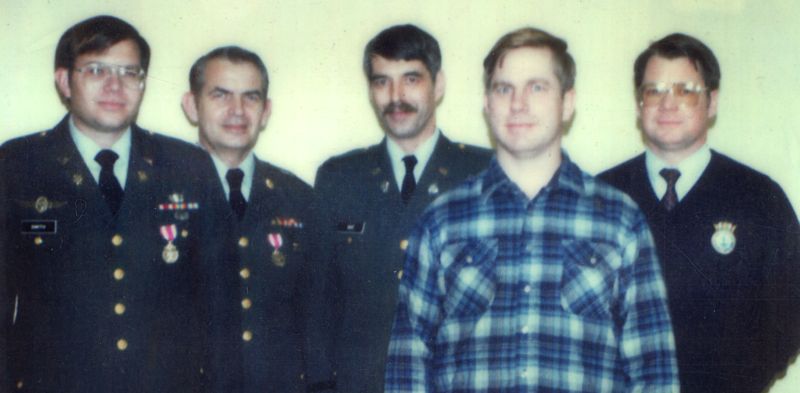The Real Men Behind “The Men Who Stare at Goats”
by Paul H. Smith

Some of the real men who didn’t stare at goats. (L to R: Paul H. Smith, Lyn Buchanan, Bill Ray, Skip Atwater & Lieut. Col. Brian Buzby)
Here is my list of a few of the more prominent characters in the movie, The Men Who Stare At Goats, and the real people and composites they might represent, based on what I remember from my first time seeing the film:
The George Clooney character (“Lyn Cassidy”):
- “Loosely based” on Special Forces remote viewer Glenn Wheaton (closing credits).
- Is named “Lyn” (a reference to remote viewer Lyn Buchanan).
- Is nicknamed both “Skip” and “Skipper” (a reference to Army RV program founder F. Holmes “Skip” Atwater).
- Caused Army computers to go on the fritz as he walks by (Lyn Buchanan again).
- Kills a goat by staring at it (based on an account related by Glenn Wheaton).
- Finds a NATO general kidnaped in Italy (based on an action by legendary Star Gate remote viewer Joe McMoneagle).
- Uses mind powers to “burst” clouds (a reference to Col. John Alexander, staff officer in charge of exploring human potentials for the Army’s Intelligence and Security Command).
- Goes to Iraq (could be remote viewer Bill Ray, since he is the only former Star Gate member to go to Iraq during the current US involvement there — or it could instead just be a plot device inspired by the book).
- Holds the rank of sergeant first class (Lyn Buchanan and Glenn Wheaton).
The Jeff Bridges character (“Bill Django”):
- “Loosely based” on Jim Channon (closing credits). “Django” is clearly Jim Channon, of “First Earth Battalion” fame, though a case could be made that the character has some elements of John Alexander.
The Nick Offerman character (“Scotty Mercer”):
- In a remote viewing trance, “Mercer” says to ask a certain prominent female television personality for further information (something Lyn Buchanan did).
The Kevin Spacey character (“Larry Hooper”):
- “Hooper” does off-the-books LSD experiments on “Norm Pendleton” (played by Arron Shiver), an unwary remote viewing recruit. The recruit flips out and eventually walks onto a military parade field firing a .45 pistol into the air, then shoots himself. “Hooper” is reminiscent of Ed Dames, who pursued off-the-books remote viewing tasking of viewers on weird targets such as UFOs — though none of Dames’s viewers flipped out. The suicidal “Pendleton” is a caricature of a real lieutenant who was called by the pseudonym “Pemberton” in both Jim Schnabel’s book, Remote Viewers and in Paul H. Smith’s Reading the Enemy’s Mind. But in real life “Pemberton” never threatened anyone with a gun, and he did not commit suicide; he returned to active duty and finished out an honorable career.
- Long after the psychic spy program’s demise, Hooper starts up his own version of it to get government contracts. (Again reminiscent of Ed Dames, who started his company Psi Tech to commercialize remote viewing techniques.)
The Stephen Lang character (“General Hopgood”):
- Is an over-the-top portrayal of Major General Bert Stubblebine, the commander of the Army’s Intelligence and Security Command during the early 1980s, who did try to walk through a wall once (not run through it, and certainly didn’t try to do it more than once). The real-life Stubblebine fought courageously to try to keep the military remote viewing program alive, even at the cost of his own career.
Finally, there is one lone remark in the film about a remote viewer named ‘Mel’ — a reference to Master Sergeant Mel Riley, the only remote viewer to be assigned to the Star Gate program more than once.


